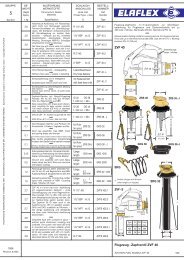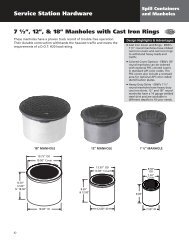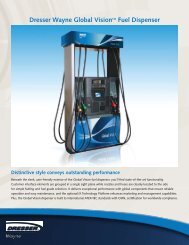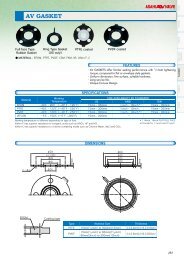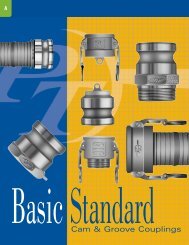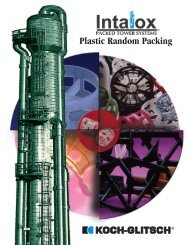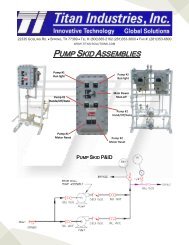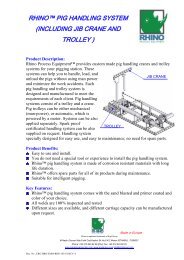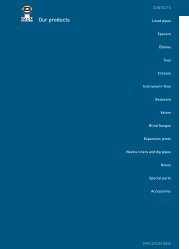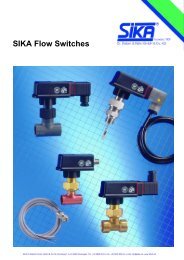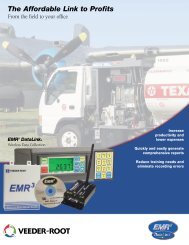Print 102715_Koch - L.B.L Trading Ltd.
Print 102715_Koch - L.B.L Trading Ltd.
Print 102715_Koch - L.B.L Trading Ltd.
Create successful ePaper yourself
Turn your PDF publications into a flip-book with our unique Google optimized e-Paper software.
Liquid-Liquid Dispersions-<br />
Why They Occur<br />
Mixtures of two immiscible liquids occur throughout<br />
the process industries. Often this is an unavoidable<br />
result of the process. In other cases, the<br />
mixing of two liquids is necessary to obtain mass<br />
transfer between the phases or to promote a<br />
chemical reaction. Almost always, a full separation<br />
of the liquids will be important for efficient and<br />
cost effective performance of the downstream<br />
process.<br />
Design of Coalescer Vessels<br />
Many separators consist merely of a horizontal<br />
vessel, as shown in the diagram below, where the<br />
separation occurs by allowing the droplets to settle<br />
by gravity.<br />
Droplets rise (when they are the lighter phase<br />
liquid) or fall (when the heavier phase) based on<br />
the following equation, which is derived from<br />
Stoke’s Law:<br />
The size of the resulting droplets (dispersed phase),<br />
and the ease of their separation from the continuous<br />
phase are partially dependent on how the dispersion<br />
is created, as shown in the chart below:<br />
Mechanical<br />
static mixers<br />
mechanical agitator<br />
centrifugal pump<br />
two phase flow<br />
Condensation<br />
heat exchanger from vapor<br />
from saturated liquid<br />
Chemical reaction<br />
0.1 1.0 10 100 1000<br />
Drop Size, microns<br />
V = g ( ρ H - ρ L ) D2 / 18µ<br />
V = Settling velocity (cm/sec)<br />
g = Gravitational constant (98/cm/sec 2 )<br />
µ = Viscosity of continuous phase (poise)<br />
ρ H = Density of heavy liquid (g/cm 3 )<br />
ρ L = Density of light liquid (g/cm 3 )<br />
D = Droplet diameter (cm)<br />
For a water droplet falling in an oil with a density<br />
of 800 Kg/m3 (50 lb./cu. ft.), the settling rates are<br />
shown in graph 1 below. These traditional separators<br />
are not economical because they require long residence<br />
times to achieve separation of even 150 - 200<br />
micron droplets. They are rarely justified in new<br />
Equally important are the physical properties of the<br />
two liquids, including interfacial tension, density<br />
difference and viscosity. The presence of solids and<br />
trace impurities, as well as pH and temperature<br />
changes can completely alter the characteristics and<br />
ease of separation. For example, it is quite possible<br />
for even a few ppm of impurities to change an easy<br />
separation to a difficult emulsion.<br />
Because of this complexity, a theoretical calculation<br />
describing the separation of two liquids can only be<br />
done based on assumptions of pure liquids, which<br />
never occurs in the real world. Therefore, the selection<br />
and design of liquid separation equipment is<br />
based on a combination of basic principles, experience<br />
and trial testing.<br />
Settling Velocity, cm/sec<br />
3<br />
2<br />
1<br />
0<br />
O 50 100 150 200 250 300 350 400 450 500<br />
Drop size, microns<br />
Graph 1: Droplet settling velocity<br />
designs unless large surge capacity is required for<br />
process reasons, or because of very heavy solids<br />
loadings or high viscosity liquids in the process.<br />
1
Some Typical Solutions<br />
Benefits from Modern<br />
Coalescer Technology<br />
• Reduce size and cost of new<br />
liquid-liquid separators<br />
• Improve product purity in existing<br />
installations<br />
• Debottleneck existing reflux drums<br />
• Reduce downstream corrosion caused<br />
by corrosive liquid carryover<br />
• Reduce losses of glycol, amine and<br />
other valuable chemicals<br />
• Improve fractionation tower operation<br />
and reduce maintenance<br />
• Reduce fugitive VOC emissions<br />
Refinery & Chemical<br />
Applications<br />
Hazy Distillates occur when dissolved water<br />
condenses from solution while the product<br />
cools in storage tanks. This can result in tying<br />
up product in inventory for days or weeks while<br />
the water settles to allow meeting haze specifications.<br />
Proper coalescers have allowed almost<br />
immediate use of the product in blending and<br />
final product sale, reducing carrying costs.<br />
Caustic Treaters often allow carryover of sodium<br />
into the product, making it difficult to meet final<br />
product specification in this regard. Subsequent<br />
water washing of the product can be virtually<br />
eliminated by installation of proper caustic<br />
coalescers.<br />
Acid Alkylation Plants have multiple locations<br />
where feeds and alkylates are mixed with aqueous,<br />
acid and caustic streams as part of the process.<br />
Each location has unique operating properties<br />
demanding careful choice of media and a strong<br />
knowledge of the process implications.<br />
MTBE and TAME plants have been retrofitted<br />
with the KOCH-OTTO YORK ® vertical flow<br />
COALEX liquid-liquid separator in both the<br />
main and methanol wash columns.<br />
LPG Treaters routinely add KOCH-OTTO YORK ®<br />
coalescers to debottleneck towers for additional<br />
capacity.<br />
Natural Gas Purification<br />
Glycol and amine systems both suffer from foaming<br />
problems caused by liquid hydrocarbon carryover<br />
in the natural gas or light ends. Excessive chemical<br />
losses generally occur with traditional skimmers,<br />
and immediate payback is obtained by retrofitting<br />
with high efficiency coalescer media.<br />
Waste Water Treatment<br />
Reducing loads on existing water treatment<br />
facilities, by treating specific sources within<br />
the plant, reduces total investment.<br />
For ground water runoff, underground clarifiers and<br />
coalescer vaults are often used to remove unwanted<br />
oils or sediment. Improvement in performance,<br />
service life and capacity has been shown for many<br />
installations using KOCH-OTTO YORK ® products.<br />
Performance below 10 ppm residual oil in the water<br />
discharge is routinely obtained.<br />
Fractionator Overhead Reflux Drums often<br />
become a bottleneck when distillation towers<br />
are retrofitted with higher capacity internals.<br />
In most reflux drums, capacity can be at least<br />
doubled with the installation of the proper<br />
liquid-liquid separation media to prevent<br />
carryover of water condensate in the reflux<br />
or product.<br />
2
Improving the Process<br />
Droplet settling is strongly affected by both the<br />
droplet size and the distance the droplet must settle<br />
before it reaches the interface between the two liquid<br />
phases. Both of these factors can be influenced<br />
through the intelligent selection of internals to<br />
accelerate the separation.<br />
Parallel Plate Separators<br />
KY-FLEX TM Media<br />
These corrugated plate separators are an improvement<br />
over the parallel plate separators except where<br />
severe solids loadings require the extra large spaces<br />
that the parallel plates allow. Properly structured,<br />
the corrugations provide superior collection and<br />
drainage channels for liquids and solids. A variety<br />
of corrugation geometries and spacings are available<br />
to optimize the fouling resistance and efficiency to<br />
the needs of each process.<br />
While droplets larger than 200 - 300 microns<br />
diameter will settle quickly, as shown in graph<br />
1 on page 1, smaller droplet dispersions require<br />
excessive settling times, when they must travel long<br />
distances to the interface. By the use of multiple<br />
horizontal, parallel plates, the designer can create<br />
many interfaces within the same vessel, as can be<br />
seen below, allowing significant reductions in<br />
PARALLEL-PLATE CONCEPT<br />
OIL<br />
HEAVY SEDIMENTS<br />
CORRUGATED-PLATE CONCEPT<br />
separator vessel sizes.<br />
For dispersions down to 50 - 100 microns it is possible<br />
to achieve efficient separation with this technique,<br />
and it is the preferred equipment design<br />
where the potential for solids or tarry liquids exists.<br />
3
YORKMESH TM Media<br />
The second approach focuses on increasing the size<br />
of droplets, by coalescing them into the easily separated<br />
drops larger than 200 microns, so they will<br />
quickly separate by gravitational force. Generally,<br />
this technique is aimed at the smaller droplets, from<br />
100 microns down to a few microns diameter, which<br />
settle very slowly or not at all. Often referred to as<br />
secondary dispersions, haze or emulsions, these<br />
applications present the biggest challenge, and are<br />
solved with high performance coalescing media,<br />
often custom engineered for the properties of the<br />
specific chemicals involved.<br />
Fiber Media<br />
These specially engineered elements are applied to<br />
the most difficult separation applications, where<br />
even long settling times do not allow complete<br />
emulsion separation. Although more expensive by<br />
themselves, their cylindrical geometry allows efficient<br />
use of the internal vessel space, making them<br />
a popular choice to minimize separator vessel size,<br />
or to maximize throughput in existing vessels.<br />
These elements commonly use glass fiber,<br />
polypropylene, carbon or ceramic fiber depending<br />
on the chemical corrosion and wettability.<br />
They consist of mixtures of metal and non-metallic<br />
wires and fibers. The internal geometry promotes<br />
droplet size growth and maximizes liquid<br />
throughput velocities for minimum vessel sizes.<br />
Choosing the Best Media<br />
With over 40 years experience providing<br />
coalescers, KOCH-OTTO YORK ® has developed a<br />
large library of knowledge based on successful<br />
applications, which is the best starting point for<br />
selecting the right solution the first time.<br />
Parallel Plate KY-FLEX YORKMESH Fiber Media<br />
Cost, w/o vessel* 3.0 – 5.0 1.5 – 2.5 1.0 1.5 – 3.0<br />
Cost, incl. Vessel* 2.0 – 3.0 0.8 – 1.0 1.0 0.8 – 1.5<br />
Capacity* 0.75 – 1.0 1.25 – 1.5 1.0 0.8 – 1.25<br />
Efficient performance range ≥ 75 microns ≥ 25 microns 2 – 25 microns 2 microns<br />
Pressure Drop, WC 25 mm (1") 25 – 100 mm 50 – 1000 mm 50 – 1000 mm<br />
(1" – 4") (2" – 40") (2" – 40")<br />
Solids Handling Designed for<br />
fouling service<br />
Good fouling<br />
resistance<br />
Limited solids<br />
capability<br />
Non-fouling<br />
service only<br />
* Values are relative to YORKMESH media<br />
≥<br />
≥<br />
4
Converting Experience into<br />
Solutions<br />
The best solution to every liquid-liquid separation<br />
application requires evaluating a variety of design<br />
factors before the most cost effective solution is<br />
selected. While the design can not be reduced<br />
to a series of equations, as already discussed, a<br />
systematic approach will lead to the right selection.<br />
Collect Data on the Process<br />
As already noted, the method of droplet creation<br />
will often give a good indication about the difficulty<br />
of separation. Physical properties of each phase<br />
and other data need to be collected:<br />
♦ density differences and viscosity determine<br />
how fast the droplets will disengage,<br />
♦ flowrates will determine the ultimate size of<br />
the required separation equipment,<br />
♦ desired separation performance must be<br />
defined,<br />
♦ interfacial tension, which is a measure of<br />
the ease of droplet coalescing and how it is<br />
affected by pH and temperature, is very<br />
helpful when available,<br />
♦ presence of impurities and solids will often<br />
create a more difficult separation, since<br />
they can collect at the interface between the<br />
liquids, making coalescing difficult and also<br />
limiting equipment choices,<br />
♦ relative solubility at operating temperature<br />
will help the designer understand whether<br />
the desired separation is being prevented by<br />
solubility limits.<br />
minutes, it is generally possible to provide a<br />
straightforward solution. If the main separation<br />
occurs quickly, but a haze remains in one or both<br />
liquids long after the primary separation, a more<br />
difficult problem exists. If the phases are still partially<br />
or completely mixed after several days of settling<br />
an emulsion is present which can only be<br />
solved with high performance designs.<br />
Field or Laboratory Testing<br />
For assurance of coalescer performance, testing<br />
of the actual process stream under actual operating<br />
conditions gives the highest level of confidence<br />
that performance objectives will be met. In the<br />
most difficult applications involving stable<br />
emulsions, it is the only true way of assuring<br />
a satisfying solution.<br />
The KOCH-OTTO YORK ® pilot plant facility in<br />
Houston, Texas regularly conducts tests on customer<br />
feed samples which closely replicates the actual<br />
plant process conditions. Tests run in a 100 mm (4<br />
inch) diameter unit, with run times of several days,<br />
produce data that can be reliably scaled up to commercial<br />
solutions. Samples of 400 - 500 litres (100<br />
- 150 gallons) of actual plant material are required.<br />
Qualifying Separation<br />
Difficulty<br />
With this information, an experienced KOCH-<br />
OTTO YORK ® engineer can begin to define the<br />
solution and foresee warning signals that should be<br />
considered. A simple bench-top test is often recommended<br />
at this point if the process operates near<br />
atmospheric conditions. By collecting an actual<br />
sample of the process stream and watching it settle,<br />
the time required for the liquids to separate will<br />
provide enough information to reach preliminary<br />
design conclusions. When separation occurs within<br />
Since small uncertainties can still exist, because of<br />
possible changes in the emulsion during shipping<br />
and storage, the most reliable design data will<br />
always be obtained by onsite slipstream testing at<br />
actual process conditions.<br />
5
Onsite Pilot Testing<br />
For this purpose, KOCH-OTTO YORK ® has specially<br />
designed rental testing units, available throughout<br />
the world, which can be shipped to the customer’s<br />
plant. These units are capable of safely operating at<br />
high pressures and temperatures when necessary to<br />
evaluate the performance of various media.<br />
Media Construction<br />
Materials<br />
For these high performance coalescers, selection of<br />
the element’s construction materials can be an<br />
important consideration. It is generally preferred<br />
that the dispersed phase preferentially wet the<br />
media. Sometimes this is absolutely critical to<br />
performance, while in other cases it makes no<br />
noticeable difference. Coalescer performance is<br />
generally based on the expectation that the droplets<br />
wet the coalescer media allowing collection and<br />
droplet growth, rather than bouncing off.<br />
Vertical Towers<br />
Coalescers are installed in both horizontal flow<br />
and in vertical vessels, and this strongly affects the<br />
coalescer media internal geometry requirements.<br />
Light Outlet<br />
Measurements of pressure drop, flow rates, and separation<br />
efficiency may be taken by the customer or<br />
experienced KOCH-OTTO YORK ® engineers. The<br />
collected data give the best possible understanding<br />
for the tested stream, including the effects of contaminants,<br />
the potential for fouling or corrosion, and<br />
any other unforeseen complications. Performance<br />
guarantees to duplicate test unit performance are<br />
routinely given.<br />
DPI<br />
Light phase<br />
out<br />
Heavy Feed<br />
Light Feed<br />
COALEX<br />
Contacting<br />
Zone<br />
Rotameter<br />
Globe valve<br />
High efficiency<br />
media<br />
Sight<br />
port<br />
Interface<br />
indicator<br />
The testing units are fully operational, selfcontained<br />
packages, consisting of pressure<br />
vessels (certified to such local codes as ASME,<br />
Stoomwezen, Codap and Ad-Merkblatt) with<br />
sight glasses to observe performance, instrumentation<br />
and piping.<br />
Pl<br />
Heat phase<br />
out<br />
Tl<br />
6<br />
Heavy Outlet<br />
In vertical vessels, such as counter-current flow<br />
solvent extractors or wash columns, it has been<br />
common industry practice to install a horizontal<br />
flow coalescer in a separate, external vessel. By<br />
installation of a COALEX liquid-liquid separator<br />
within the extraction/wash column, as shown above,<br />
a separate vessel, with its instrumentation, plot plan<br />
space, foundations and installation costs, is<br />
eliminated.
KOCH-OTTO YORK ®<br />
Design & Service Leader in<br />
Separations Technology.<br />
Members of the<br />
<strong>Koch</strong>-Glitsch Business Group<br />
42 Intervale Road<br />
P.O. Box 3100<br />
Parsippany, NJ 07054-3100<br />
TEL: 973-299-9200<br />
800-524-1543<br />
FAX: 973-299-9401<br />
6611 Killough Road<br />
Houston, TX 77086<br />
TEL: 281-445-7026<br />
800-736-7036<br />
FAX: 281-445-7032<br />
4111 E. 37th St. North<br />
Wichita, KS 67220<br />
TEL: 316-828-7181<br />
FAX: 316-828-8018<br />
<strong>Koch</strong>-Glitsch Italia S.r.l.<br />
Via Tonale 50<br />
P.O. Box 13<br />
24061 Albano S. Alessandro<br />
(Bergamo) Italy<br />
TEL: 39-035-328611<br />
FAX: 39-035-328601<br />
<strong>Koch</strong>-Otto York BVBA<br />
Bijkhoevelaan 12<br />
B - 2110 Wijnegem, Belgium<br />
TEL: 32-3-647-2847<br />
FAX: 32-3-647-2879<br />
Otto York Asia Pacific<br />
260 Orchard Road, #11-01/09<br />
The Heeren<br />
Singapore 238855.<br />
TEL: 65-831-6410<br />
FAX: 65-835-2025<br />
Visit us on the internet: www.koch-ottoyork.com<br />
© 2002 KOCH-OTTO YORK ® , A <strong>Koch</strong>-Glitsch Business Group<br />
KY-FLEX, COALEX and YORKMESH, are trademarks<br />
for our Liquid-Liquid Coalescer products.<br />
All data in this brochure are for general information only and are based on<br />
tests carried out under conditions which may or may not apply to your<br />
requirements. No warranties or guarantees are expressed or implied. No<br />
information contained in this brochure constitutes an invitation to infringe any<br />
patent, whether now issued or issued hereafter. All descriptions and<br />
specifications are subject to change without notice.<br />
<strong>Print</strong>ed in the USA.<br />
Bulletin CO5603-2 5M0502B <strong>Print</strong>ed in U.S.A.<br />
©Copyright 2002 <strong>Koch</strong>-Otto York



